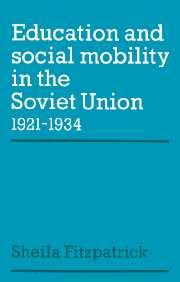10 - The restoration of order: new policies in education, 1931–1934
Published online by Cambridge University Press: 11 November 2009
Summary
The policies which came under the general heading of Cultural Revolution – harassment of the old intelligentsia and massive recruitment of workers and Communists to higher education – were introduced in 1928 and reached a peak of intensity in 1930/31. But by the middle of 1931, there were signs that the Cultural Revolution had run its course. The pool of willing and even partially qualified worker and Communist applicants for higher education showed signs of drying up. The industrial enterprises were resisting further inroads on their skilled labour force; and the industrial leadership was actively campaigning for an end to the persecution of the old engineers. In the summer of 1931, the ‘bourgeois intelligentsia’ was formally rehabilitated in a speech by Stalin. In the autumn, the organized recruitment of workers to full-time study in the VTUZy was quietly abandoned.
Cultural Revolution, however, had meant more than proletarian vydvizhenie and the harassment of bourgeois specialists; and the restoration of order in education and cultural life was consequently a complex and many-faceted process. It is likely, indeed, that the party leadership only became fully aware of the dimensions of the cultural upheaval it had sponsored when the time came to reverse the policy.
Cultural Revolution had meant, in the first place, the establishment of ‘proletarian hegemony’ in the cultural professions by groups of militant Communist intellectuals.
- Type
- Chapter
- Information
- Education and Social Mobility in the Soviet Union 1921–1934 , pp. 209 - 233Publisher: Cambridge University PressPrint publication year: 1979



